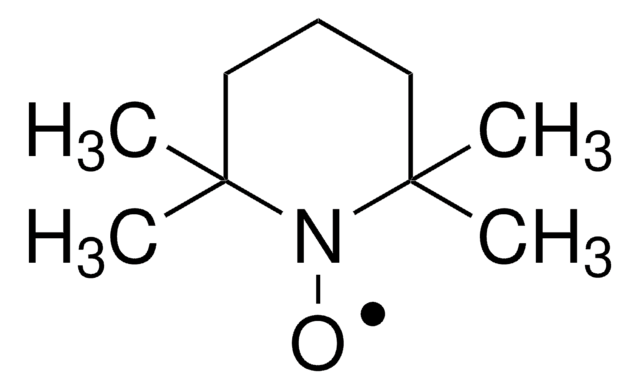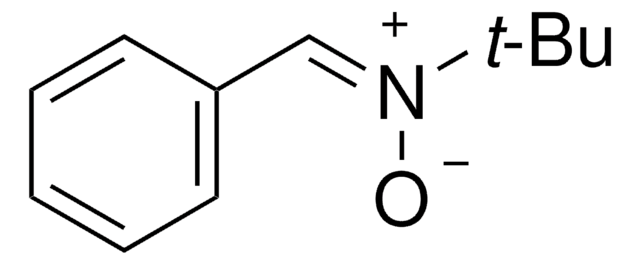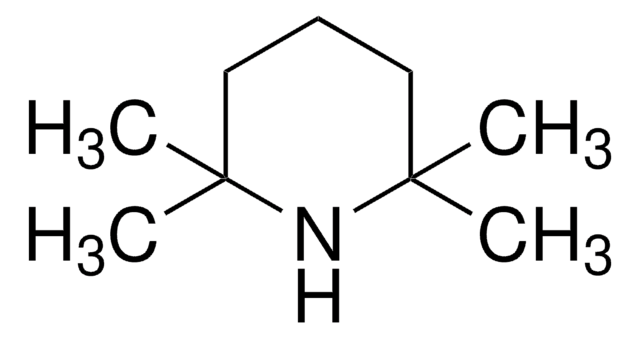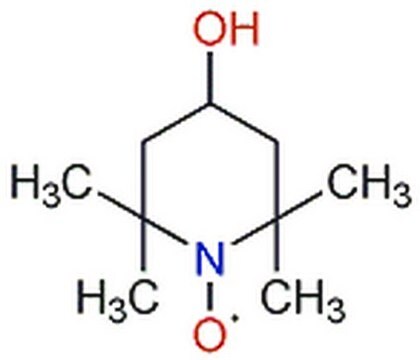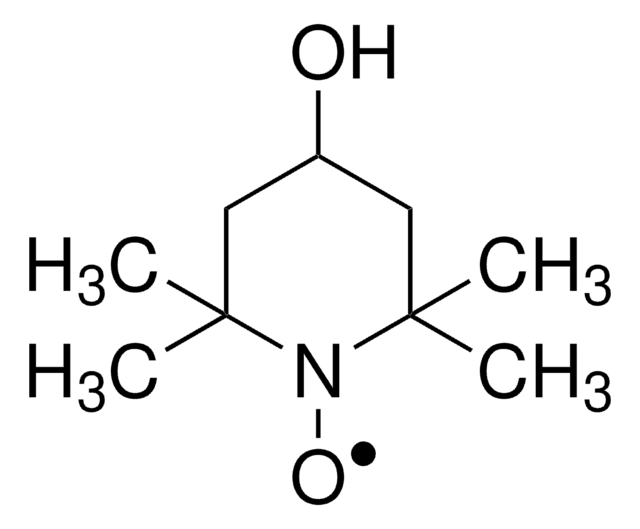92688
5,5-Dimethyl-1-pyrroline N-oxide
for ESR-spectroscopy
Sinónimos:
DMPO
Iniciar sesiónpara Ver la Fijación de precios por contrato y de la organización
About This Item
Fórmula empírica (notación de Hill):
C6H11NO
Número de CAS:
Peso molecular:
113.16
Beilstein:
107603
Número CE:
Número MDL:
Código UNSPSC:
12000000
ID de la sustancia en PubChem:
NACRES:
NA.21
Productos recomendados
grado
for ESR-spectroscopy
Nivel de calidad
Ensayo
≥98.0% (GC)
Formulario
crystals
índice de refracción
n20/D 1.496 (lit.)
bp
75 °C/0.4 mmHg (lit.)
mp
25-29 °C (lit.)
densidad
1.015 g/mL at 25 °C (lit.)
temp. de almacenamiento
−20°C
cadena SMILES
CC1(C)CCC=[N+]1[O-]
InChI
1S/C6H11NO/c1-6(2)4-3-5-7(6)8/h5H,3-4H2,1-2H3
Clave InChI
VCUVETGKTILCLC-UHFFFAOYSA-N
¿Está buscando productos similares? Visita Guía de comparación de productos
Categorías relacionadas
Aplicación
5,5-Dimethyl-1-pyrroline N-oxide is a reagent generally used either as a free-radical spin-trapping agent, or electrophilic component during the synthesis of pyrrolidine derivatives. It may also be considered as 1,3-dipole in cycloaddition processes.
Neuroprotective agent; nitric oxide spin trap. Used to study radicals formed by enzymatic acetaldehyde oxidation.
Neuroprotective agent; nitric oxide spin trap. Used to study radicals formed by enzymatic acetaldehyde oxidation. Incubation of lymphocytes with DMPO decreased DNA damage by NiCl2.
Envase
Bottomless glass bottle. Contents are inside inserted fused cone.
Código de clase de almacenamiento
11 - Combustible Solids
Clase de riesgo para el agua (WGK)
WGK 3
Punto de inflamabilidad (°F)
203.0 °F - closed cup
Punto de inflamabilidad (°C)
95 °C - closed cup
Elija entre una de las versiones más recientes:
¿Ya tiene este producto?
Encuentre la documentación para los productos que ha comprado recientemente en la Biblioteca de documentos.
Karim Michail et al.
Analytical chemistry, 84(15), 6739-6746 (2012-06-26)
Free radicals are conventionally detected by electron paramagnetic resonance (EPR) spectroscopy after being trapped as spin adducts. Albeit this technique has demonstrated utmost efficacy in studying free radicals, its application to biological settings is intrinsically hampered by the inevitable bioreduction
Murugesan Velayutham et al.
Free radical biology & medicine, 51(1), 160-170 (2011-05-07)
In cells, mitochondria, endoplasmic reticulum, and peroxisomes are the major sources of reactive oxygen species (ROS) under physiological and pathophysiological conditions. Cytochrome c (cyt c) is known to participate in mitochondrial electron transport and has antioxidant and peroxidase activities. Under
Pedro L Zamora et al.
The journal of physical chemistry. A, 116(26), 7210-7218 (2012-06-07)
Radical forms of sulfur dioxide (SO(2)), sulfite (SO(3)(2-)), sulfate (SO(4)(2-)), and their conjugate acids are known to be generated in vivo through various chemical and biochemical pathways. Oxides of sulfur are environmentally pervasive compounds and are associated with a number
Emiko Sato et al.
Journal of biochemistry, 150(2), 173-181 (2011-05-17)
The nicotinamide adenine dinucleotide (NADH)/nicotinamide adenine dinucleotide phosphate (NADPH) oxidase and the xanthine oxidase (XOD) systems generate reactive oxygen species (ROS). In the present study, to characterize the difference between the two systems, the kinetics of ROS generated by both
Suchandra Bhattacharjee et al.
Nucleic acids research, 40(12), 5477-5486 (2012-03-06)
Oxidative stress-related damage to the DNA macromolecule produces lesions that are implicated in various diseases. To understand damage to DNA, it is important to study the free radical reactions causing the damage. Measurement of DNA damage has been a matter
Nuestro equipo de científicos tiene experiencia en todas las áreas de investigación: Ciencias de la vida, Ciencia de los materiales, Síntesis química, Cromatografía, Analítica y muchas otras.
Póngase en contacto con el Servicio técnico